

Classic Buses Profiles
Blandford to Leeds by fifteen buses in 1956 (by Dick Gilbert)
Last updated 28 July 2020
SOME LINKS WITHIN THIS WEBSITE: Home Email Links THE COMPLETE WEBSITE MENU Events Diary Halfcab list Small-Ads Classic Irish Buses Classic Manx Buses
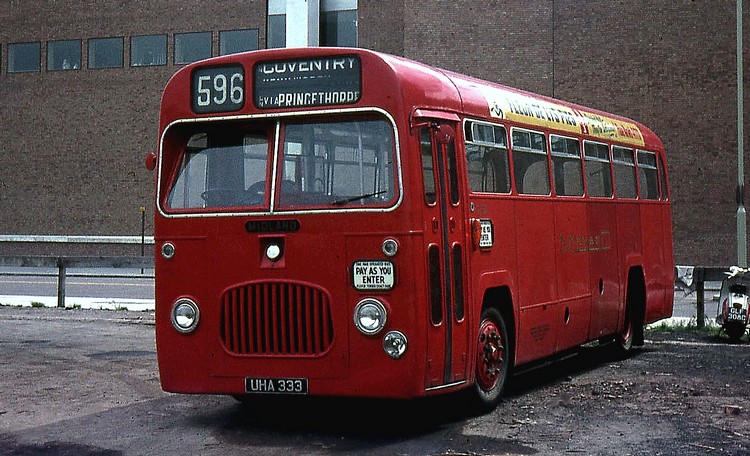
It was on a Midland Red BMMO S14 like this that Roland travelled from Ledbury to Evesham on stage eight of this marathon journey. The picture (taken in Pool Meadow, Coventry) was kindly supplied by Brian Bennett.
In April 2020 Roland Niblett kindly sent me the attached story. He said "I thought you might be interested in this journal I kept in 1956 of a three-day trip by local buses from my boarding school at the time (Bryanston in Dorset) to my home in Leeds. Alas I didn't have a camera to record the vehicles I travelled in, but you may well have access to photos of at least some of them."
Indeed it has been possible to obtain some photos, so many thanks to all the kind people who let me use them, and thanks very much to Roland for sending this tale of a remarkable journey.
The livery on this page is a tribute to Midland Red, who provided three buses during the trip.
Clearing out the attic one day recently I came across a notebook containing details of a journey I made by local buses back in 1956, just 45 years ago. At the tender age of 14, my parents allowed me to travel from school in Dorset to home in Leeds over a period of three days. Difficult to imagine boys of that age being allowed to do such a thing nowadays.
The idea had gradually formed over a period, spurred on by a very helpful lady at the passenger information bureau at Leeds Bus Station. Of course there was no national bus timetable then and County Councils had no responsibilities to produce public transport guides for their areas, but most of the operating companies produced their own. As each new timetable was sent to the enquiry office at Leeds, the out-of-date ones would be thrown away or, if you were lucky, given to anyone who pestered "Have you got any old timetables please?" Gradually I built up a collection which covered most of the country, and with these started to plan the great journey.
Fortunately the schedules didn't change much from year to year, and I didn't find any problems of missed connections. One reason for this was that the timings were very lax: almost every time the bus would leave late and still manage to get to its destination on time or early. There were few problems of traffic congestion, and most of the time we were bowling along on open roads with a most satisfying roar from a Gardner 5LW or whatever it happened to be. Passenger loadings were very variable - on some of the town-to-town services I went on most passengers travelled only within the town at each end of the route, and I had the long middle section almost to myself. But other services were more in the nature of linking villages to the nearest market town, and these were mostly well patronised.
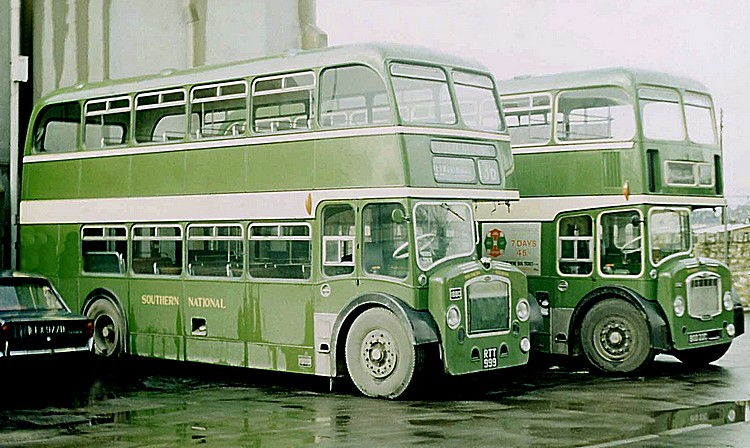
Seen on a dismal day in the 1960s is Southern National Bristol Lodekka 1880 (RTT 999) which transported Roland on the first leg (Blandford to Salisbury) of his remarkable 3-day journey from Dorset to Yorkshire. Many thanks to Bryan Bareham for the photo.
The route I followed was not exactly direct; it was influenced by several considerations - one was that I had an aunt living in Ross-on-Wye who had offered to put me up for a night, so the route had to go through there. Another was that I wanted to go through some picturesque parts of the country, such as the Peak District. I also wanted to make the journey more interesting, though perhaps also more risky, by using some services which didn't run regularly, but only once or twice a day and went through some off-the-beaten-track villages. Luckily I was never once confronted with deciding what to do when the bus I planned to go on failed to turn up, which is a wonderful tribute to the reliability of bus services then, and indeed now.
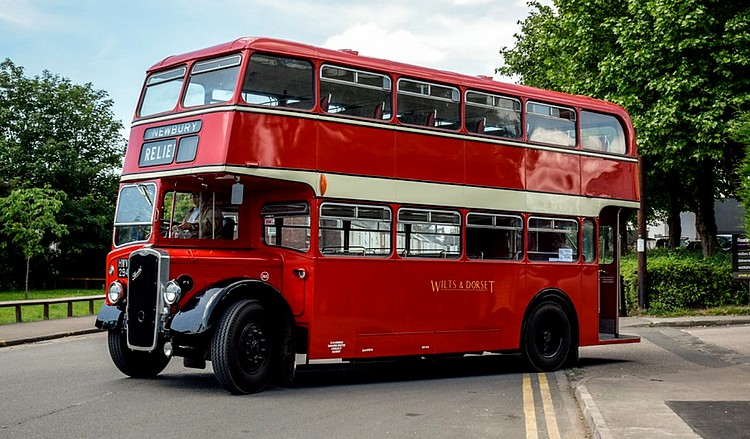
This is preserved Wilts and Dorset Bristol KSW5G HWV 294, at a running day in Reading in 2018, photographed and kindly supplied by Steve Foster. It is identical to the bus that took Roland from Salisbury to Marlborough.
My journey started at Blandford and I first went across the Plain to Salisbury on a 1955 Southern National Bristol LD6B Lodekka, fleet number 1880. RTT 999 started its journey at Dorchester on service 35 and went via Blandford army camp. Then it was a 1952 Wilts & Dorset Bristol KSW5G, HMR 415 (fleet number 346) on service 5 to Marlborough via Amesbury and over the Chalk Downs near Pewsey. There were lots of low-flying aircraft around and also a couple of deer who crossed the road just in front of us.
20 minutes of wandering up and down Marlborough's fascinating High Street was followed by a ride on another Bristol KSW6G belonging to the Bristol Omnibus Company, fleet no. 8349 (UHY 397). It was almost brand new in 1956 and was on service 70 to Swindon via Chisledon Camp. This was the only occasion when I was charged a child's fare. All the other conductors (no OMO then) charged me the full adult fare.
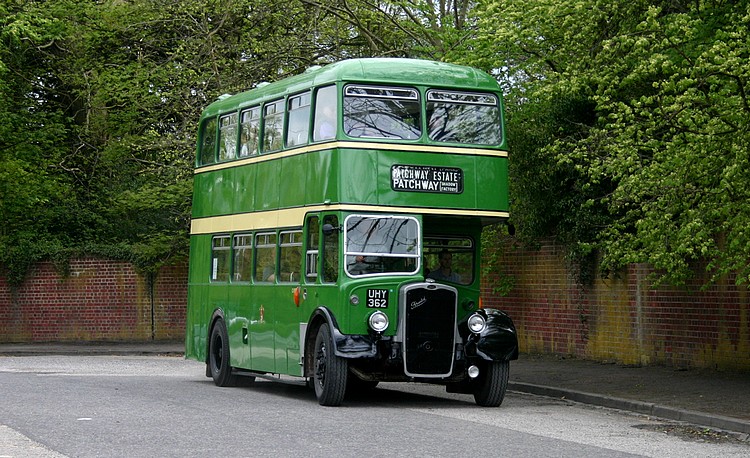
This picture by kind permission of DobiesX2 shows preserved Bristol Omnibus KSW6G no. C8322 (UHY 362) arriving at Trentham Gardens in 2010 for the annual rally. It is the same as the bus that Roland used to travel from Marlborough to Swindon
Half an hour in Swindon was enough to have some lunch and appreciate the (then) rather limited attractions of the town before getting on LAE 29, a 1948 highbridge Bristol K6B, fleet no. 3722 which took me all the way to Cheltenham on service 182 via Cricklade and Cirencester. The 35 miles took an hour and three quarters, and we had a good load for most of the way. There was plenty of opportunity to talk to some of my fellow passengers, one of whom kindly gave me some sweets, though they tasted such that I rather wished they hadn't.
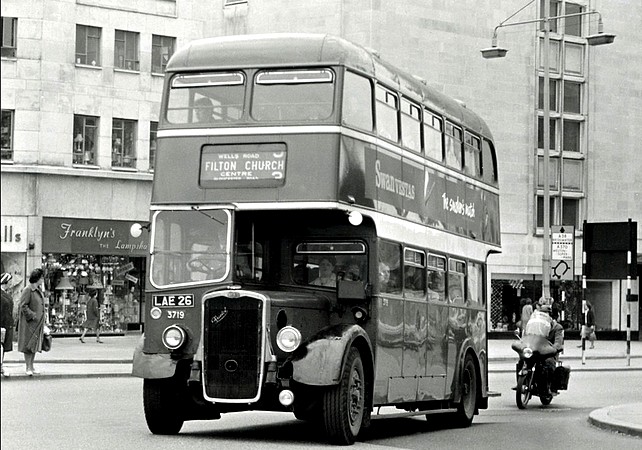
Bristol Omnibus 3719 (LAE 26) seen in Broadmead, probably in the late 1950s, by kind permission of photographer Paul Townsend. It is identical to the Bristol K6B LAE 29 that carried Roland from Swindon to Cheltenham.
Time for a break at Cheltenham, and to explore the delights of the Promenade as well as the rather more concrete environment of Royal Well Road bus station. Rather than go to Gloucester direct, I chose the more roundabout route 49A via Churchdown, and this produced the oldest bus so far, a 1941 Bristol L5G no. 2165, registered HAE 15 though with a post-war body. This route seemed to be a favourite for schoolchildren returning home (it was around 4 pm by then), and there was only just room for them all.
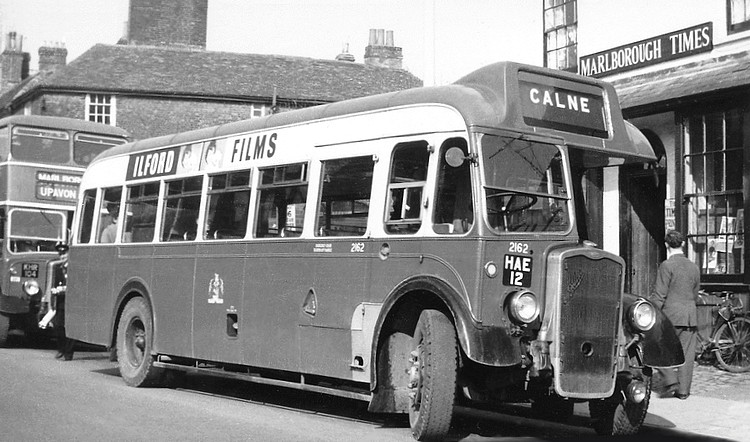
The trip from Cheltenham to Gloucester was taken in Bristol Omnibus L5G no. 2165, identical to 2162 shown here.
The last bus of that day was a Red & White from Gloucester to Ross-on-Wye. Unfortunately this did not leave from the bus station, but from Westgate Street; and, not only that, there didn't seem to be a bus stop of any kind in that long street. But luckily there was a Red & White Inquiry office, and they soon put me right, even to the extent of giving me a few more out-of-date timetables such as Eastern National and Ribble to add to my collection. When it finally turned up, about ten minutes late, the service 5 bus to Newport via Ross and Monmouth was operated by L1543 (EDG 971), a 1943 Guy Arab II with a 1952 BBW body, which started life with Cheltenham & District.
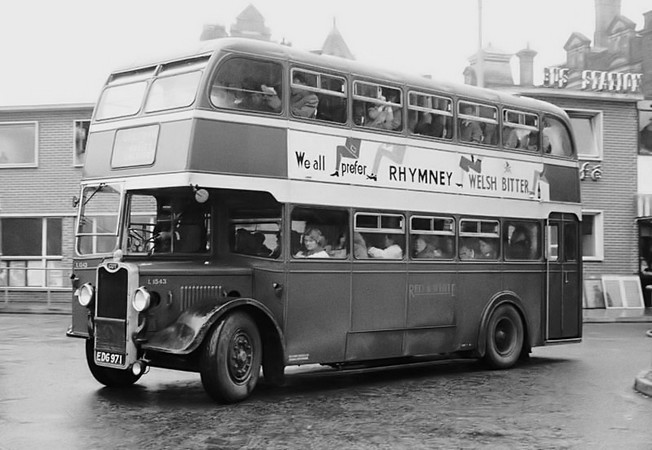
A photo of Red & White Guy Arab L1543 in Newport bus station kindly supplied by Paul Redmond. This is the very bus that took Roland from Gloucester to Ross-on-Wye.
By now it was 5.30pm, so the bus was full of people going home from work. The route didn't follow the main road, but went via B roads through Newent. I finally arrived at my Aunt's house about 10 hours after starting. If she thought I was quite crazy to be spending the time travelling about in this way, at least she was polite enough not to say so.
The next day was Saturday, and the day when country-dwellers used to go to the nearest town by bus to do their shopping; and so it was on the first bus I used, a 1950 BMMO S10 no. 3687 (NHA 687). It arrived in from Hereford on service 468 and quickly departed on route 472 to Ledbury via Upton Bishop and Old Pike, where we performed the ultimate trick of the rural bus route in turning round to go back the way we came for a short distance.
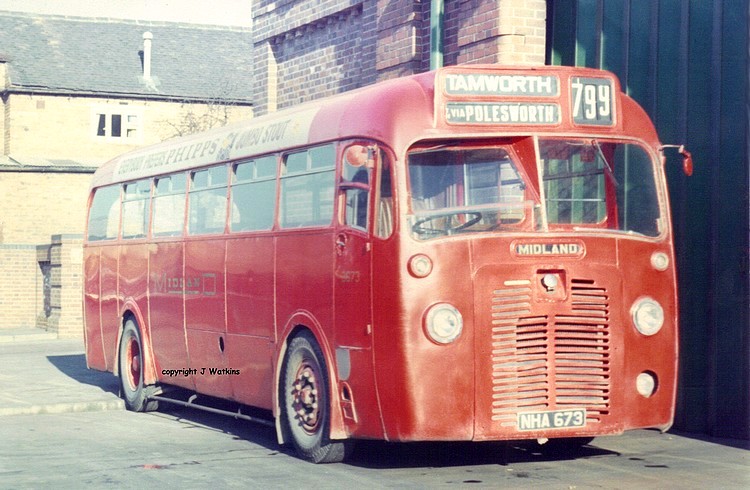
Here is similar Midland Red BMMO S10 no. 3673 (NHA 673) dating from 1950. The picture was taken (and kindly supplied) by John Watkins who said he photographed it "on a marathon bus-spotting trip from my home in Sutton Coldfield to Nottingham via Tamworth and home via Derby Bus station, a mecca for us spotters in the early sixties. It was taken outside Tamworth Midland Red Garage probably with a Kodak Brownie - all I could afford!"
Luckily we arrived at Ledbury on time, because there was only a 10 minute connection onto the X91 service, which only ran twice a day (what would I have done if I'd missed it?). This marathon route went from Hereford to Leicester via Worcester and Coventry, but I only stayed with it for the 28 miles to Evesham. The vehicle provided by BMMO that day was an ordinary stage carriage S14 (UHA 323), new in 1955. There were so many on it that I had to stand for most of the way, not that I minded. It was as good a way as any to enjoy the climb up the Malvern Hills, and later the fruit-growing area round Pershore.
After only a quarter of an hour in Evesham I was on another Midland Red, this time D5B no. 3813 (NHA 813) of 1951, on route 148 to Birmingham. It went via Bidford, Alcester and very near the future Midlands Bus Museum at Wythall where one of its sisters is preserved. There was a cricket match in progress as we passed Edgbaston before arriving at Station Street bus station at 1.40pm, though it was really no more than a collection of bus stops clustered round New Street station. One of my friends from boarding school who lived in Birmingham and had arrived home the previous day kindly met me and we found a suitably cheap cafe nearby.
Then I was off again to Ashby-de-la-Zouch on yet another Midland Red (their massive network and unique fleet had a peculiar fascination which was lost when the company was split up in the 1970s). This time it was S12 no. 3744 (NHA 744) of 1951 on service X99 to Nottingham. Like the X91, it was very full and somewhat stuffy, but I then had a 45 minute break which was useful for buying a few provisions for the next day, when all the shops would be shut.
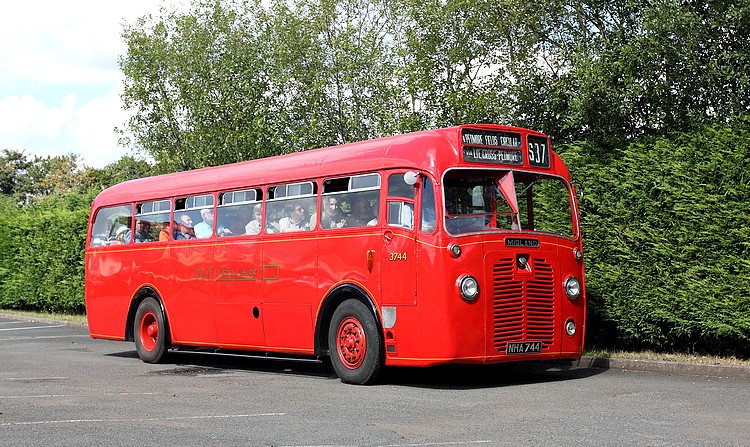
Midland Red BMMO S12 3744 (NHA 744) which carried Roland from Birmingham to Ashby still survives! It has been preserved by the Transport Museum at Wythall and was photographed in 2016 by Neil Edwards, who kindly allowed us to use the picture.
Trent provided a 1946 AEC Regal with a Willowbrook B34F body, fleet No.745 (RC 9011), for the 21A service to Derby via Lount, Melbourne and Swarkestone - not exactly the direct route, but much more interesting. Unfortunately there were very few other passengers, but that was only to be expected going towards a town late on Saturday afternoon. Although the bus was only 10 years old, it gave the impression of being much older, perhaps because even then vertical-engined single-deckers were definitely on the way out.
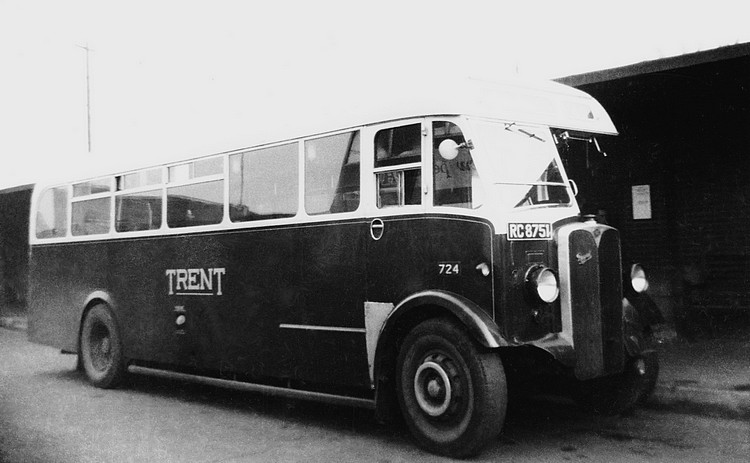
Trent Regal No.724 (RC 8751) in the 1950s. Photo from the Colin Routh collection by kind permission.
That day's destination was Ashbourne, where I was booked in to a bed and breakfast (for 35/-) at the Railway Hotel, though the station had already been closed long before. The idea of a 14 year-old staying by himself in a hotel seems rather far-fetched, but my parents must have been very broad minded, and they rightly thought that Ashbourne was a fairly quiet place. Anyway, to take me there from Derby, Trent Motor Traction provided 1946 Willowbrook-bodied AEC Regent II double-decker no. 1126 (RC 8924) which, like the Trent Regal, looked ancient but was actually only 10 years old. It went direct along the A52 at a fair lick, arriving about 7 pm. After that there was not much to do but have a meal, watch TV and go to bed.
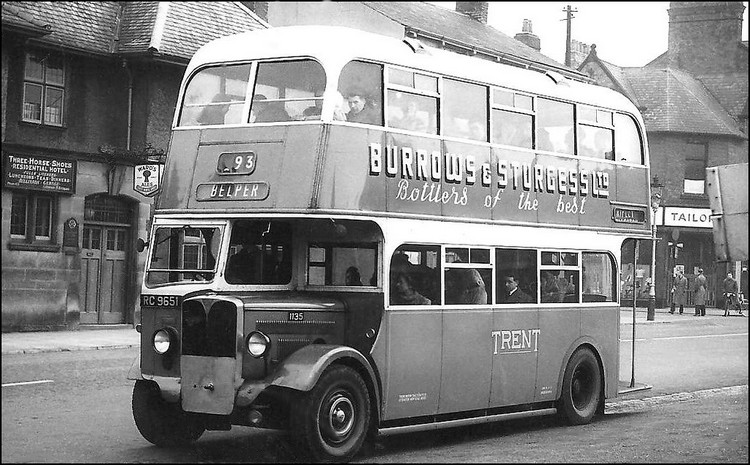
Trent no. 1135 (RC 9651), one of the many Willowbrook-bodied AEC Regent II buses that the company acquired between 1946 and 1948, waits opposite the Three Horse Shoes Hotel in Market Place, Ripley, Derbyshire. The pub is still there! Photo from the Eddie Leslie Flickr collection.
Sunday mornings are not the best times for bus travel, so I delayed my departure till lunchtime, taking the opportunity of visiting the red sandstone church. The next stop was Buxton, to which I was taken by North Western's Weymann-bodied Leyland PSU1/13 Royal Tiger No.543 (FDB 543) new in 1953. Route 65 went via A525 for most of the way, but made a detour via Hartington and Longnor.
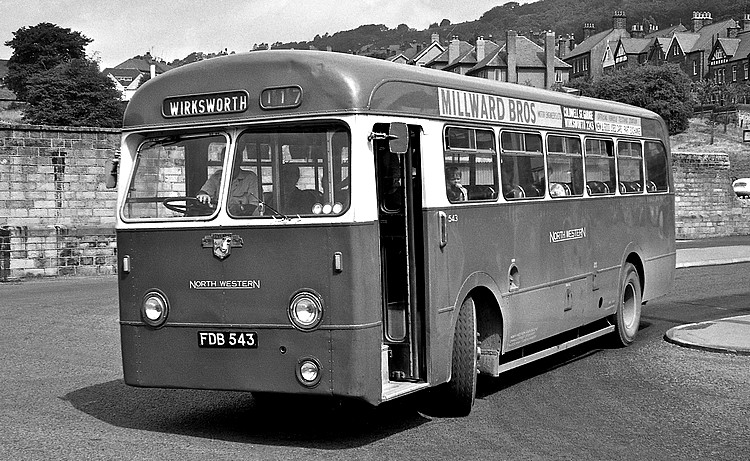
North Western Leyland Royal Tiger 543 (FDB 543) operated the leg from Ashbourne to Buxton. This fine picture of no. 543 is reproduced by kind permission of Len Wright.
I was a bit disappointed to find an identical bus, no. 519, to take me on to Sheffield on service 84, jointly operated with the Sheffield Joint Board, but nothing could detract from the scenery through Eyam and Millers Dale. This bus had a particularly helpful conductor who told me a lot about North Western bus operations, as well as where to get off in Sheffield - at the bottom of the approach to Victoria station (alas no more). From there it was only a short walk to Castlegate, where my last but one bus started from.
This was no. 764 (EHE 52), an all-Leyland PD2/12 of Yorkshire Traction, new in 1952, operating on service 67 to Leeds which was jointly run by West Riding and Sheffield. This route followed the A61 through Barnsley and Wakefield, with lengthy recovery time at each, which made for a very slow and tedious journey overall. At Barnsley bus station we waited for nearly a quarter of an hour, as well as having to pay a separate fare for the section beyond, no doubt to make things easier for the accountants who had to deal with sharing the revenues between different operators.
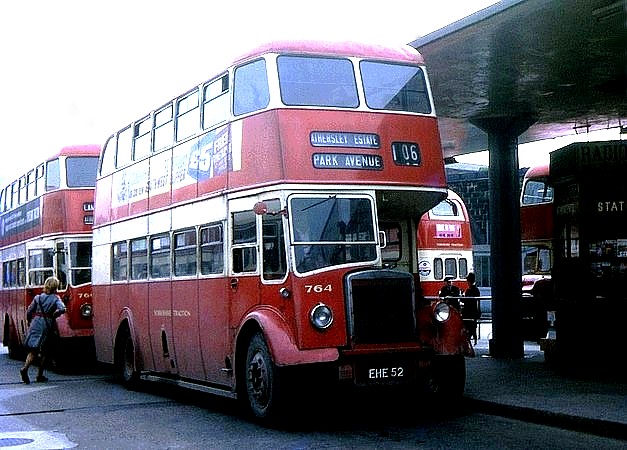
Yorkshire Traction Leyland PD2/12 764 (EHE 52) made the journey from Sheffield to Leeds. It is seen here at Barnsley in 1969, and is from the Jim Shorland collection.
The last part of my journey was over familiar streets of the Leeds suburbs, on a 1954 Leeds City Transport AEC/Roe double-decker no. 750 (TNW 750) and I finally reached home 2 days and 11 hours after setting off.
How much did it cost? Luckily I still have the tickets which were issued on each bus, so this question is easily answered: one pound and 17 shillings, for a journey of 320 miles, or 1.38 old pence per mile. But of course there was considerable variation between routes - the cheapest was between Marlborough and Swindon, because I was only charged half fare - the dearest was from Ashby-de-la-Zouch to Derby at 1.85 pence per mile.
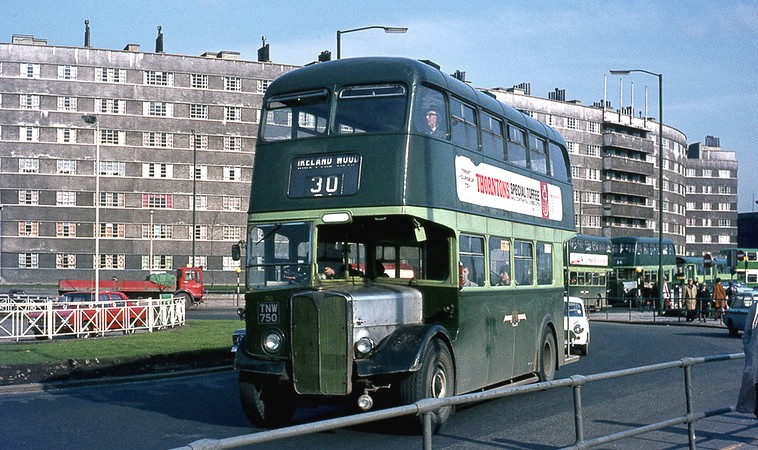
Leeds AEC Regent III 750 (TNW 750) photographed by David Christie (to whom many thanks) at St Peters roundabout in Leeds in April 1969 (it was withdrawn the following year). This was the bus that took Roland home on the final leg of his marathon journey in 1956.
But perhaps more interesting was the variety of different ticket machines used by the various companies. The commonest was the Setright, found on Southern National, Bristol and Midland Red. But one of the Midland Reds had a thin paper type of ticket of indeterminate manufacture, as did Yorkshire Traction. Trent and Wilts and Dorset both used a Bell Punch machine in which a slightly thicker card was inserted into the machine which printed the day, fare stage, class (single, return, child, etc) and the fare itself. Red and White had an older style of Bell Punch ticket, on which the conductor had to write in pencil the stage boarded, stage alighted and the fare. However the most idiosyncratic type of tickets were undoubtedly those used by the North Western Road Car Company. Manufactured by Willebrew, the ticket machine printed the stage boarded, and the direction (in or out) and cut off part of the ticket to show the fare paid - success depended on the conductor putting exactly the right length of ticket into the machine before the cut was made. I wonder when North Western stopped using this rather quaint device?
How fast was bus travel then? If we look at the scheduled times, it should have taken a total of 20 1/2 hours to cover 321 miles, which is an average of 15.7 miles per hour. Not exactly a thrilling speed with which to compete against other forms of transport, and since there were very few traffic jams it would have been easy to have faster timings. There were of course big variations between the scheduled speeds of the services I went on, from 10.7 mph between Ashby-de-la-Zouch and Derby up to 19.7 mph on the very first one, from Blandford to Salisbury. I suspect that on many routes these had remained unchanged for years, while the speed capabilities of buses had improved considerably. The only ways to cope with this situation was for buses to leave late, and/or dawdle along the route, which is exactly what happened. It was not designed to attract passengers.
But enough of carping. It was a wonderful experience, which taught me a lot about being self- sufficient, and about relating to strangers. It set the tone for many subsequent trips on local buses, the most recent being in the outer suburbs of Shanghai, when I knew hardly a word of Chinese; and I owe it all to that very helpful person in the enquiry office at Leeds Bus Station.
SOME LINKS WITHIN THIS WEBSITE: Home Email Links THE COMPLETE WEBSITE MENU Events Diary Halfcab list Small-Ads Classic Irish Buses Classic Manx Buses